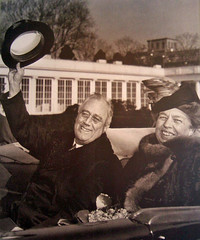 understanding of the economic policies that contributed to and helped prolong the Great Depression, see Amity Shlaes' "The Forgotten Man," published by HarperCollins in 2007].
understanding of the economic policies that contributed to and helped prolong the Great Depression, see Amity Shlaes' "The Forgotten Man," published by HarperCollins in 2007].A previous post discussed some of the similarities. But here are some of the signal differences that make the two events quite dissimilar:
- Unemployment in October 1929, the start of the Depression, stood at 5%. Within five years the unemployment rate was 23.2%. A staggering 364% increase in joblessness. We've not seen anything to even suggest we're in for that kind of job loss.
- In October 1929, the Dow Jones Industrial Average was 343. By November 1934 it closed at 93--a long, precipitous 73% drop. Free markets will periodically reset and correct themselves. But a confluence of events during the Great Depression put the economy into a free falling death spiral from which it took years to recover.
- In 1929 the Federal Reserve System was still in its infancy and its eventual role in managing the nation's money supply was yet to be defined. Today, the Fed has significant experience as a central bank and money manager, and has played a key role in stopping the bleeding in the current recession.
- The government's answer to the Great Depression was the New Deal--public policy that combined central economic planning, government largesse, and massive government public works spending. Currently, the government's response has been largely to intervene in the financial and industrial sectors but only for the purpose of maintaining the viability of those sectors as free enterprise. One of the things that helped prolong the Depression was the government's direct intervention in the industrial sector, competing for capital with private enterprise and further weakening job growth and productivity.
 There are also many misconceptions that remain about the Great Depression. One is that President Herber Hoover was a laissez-faire Republican who tried nothing to slow the Depression. Although he was not the interventionist that FDR proved to be, Hoover was the consummate technocrat who believed that the federal government had a role to play assisting "Main Street." His earlier accomplishments included spearheading successful federal flood relief efforts in the South and water projects in the West. As U.S. Commerce Secretary he oversaw the expansion of the Department.
There are also many misconceptions that remain about the Great Depression. One is that President Herber Hoover was a laissez-faire Republican who tried nothing to slow the Depression. Although he was not the interventionist that FDR proved to be, Hoover was the consummate technocrat who believed that the federal government had a role to play assisting "Main Street." His earlier accomplishments included spearheading successful federal flood relief efforts in the South and water projects in the West. As U.S. Commerce Secretary he oversaw the expansion of the Department.
Actually, Hoover did attempt to intervene in the economy. He raised taxes and signed the disasterous Smoot-Hawley Tariff Act--both very un-Republican things to do. Raising taxes confiscated valuable capital at the time the private sector needed it most to pay bills, hire labor and invest. Smoot Hawley ignited a global trade war that closed foreign markets to U.S. manufacturers, putting yet more people out of work. But a case can be made that much of FDR's New Deal, rather than solving the Depression, actually prolonged it.
 Another misconception is that World War II pulled the nation out of the Depression. Actually, two reliable economic indicators, the Dow Jones Industrial Average and the unemployment rate never returned to pre-Depression levels until 1953--20 years after the inauguration of President Roosevelt.
Another misconception is that World War II pulled the nation out of the Depression. Actually, two reliable economic indicators, the Dow Jones Industrial Average and the unemployment rate never returned to pre-Depression levels until 1953--20 years after the inauguration of President Roosevelt.
Just thought you might like to know.



1 comment:
Is this the first of a 2-part blog? If so, the title should be "The Great Depression Revisited? Part II" to make it clear to the reader that it is not a duplicate.
Post a Comment